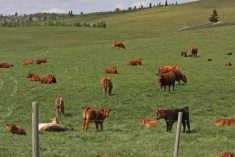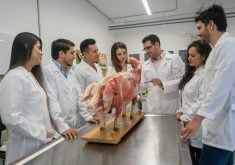ELM CREEK, Man. – Myron Pedersen’s two-month-old baby is crying and his two-year-old son is bouncing around the room, but he still manages to talking calmly about the challenges of being a young farmer.
Inside the office that is part of Pedersen’s garage, two-year-old Lane runs around the desk and over to his father to show off the remnants of a baloney sandwich.
Pedersen efficiently distracts his son by suggesting Lane feed it to the dog, Tasha, before resuming a discussion about his early days on the family farm near Elm Creek.
Read Also

Fuel rebate rule change will affect taxes and AgriStability
The federal government recently announced updates to the fuel rebates that farmers have been receiving since 2019-20.
He said he started growing his own crops when he was 14, planting 80 acres of canola with assistance from his father, Jim. That early experience obviously stuck because several years later he was farming nearly a section of land.
“I was farming 600 acres by the time I graduated university,” said Pedersen, who took the University of Manitoba’s agricultural diploma program.
Now in his 30s, Pedersen operates a 2,800 acre farm with his father, growing grain, soybeans, sunflowers, corn and other speciality crops on the flat and productive clay soil in Manitoba’s Red River Valley.
If having a two-year-old and baby wasn’t enough, Pedersen and his wife, Jodee, recently moved from the farmhouse that has been in Pedersen’s family for three generations. They now live in the town of Starbuck, 40 km east of Elm Creek and 25 km from Winnipeg.
Although he still loves the variety of tasks and challenges of growing crops, Pedersen would like to operate the farm more like a business, with employees and a manageable work day.
“With about 1,400 to 1,500 acres of that (2,800 acres) in row crop, it makes for a pretty hectic summer,” he said. “I’m willing to hire professionals for marketing … or do variable rating, to take workload off me…. Obviously employees are a huge cost but you have to have that balance of living and work.”
Jodee grew up in Winnipeg and her family is still there, so being closer to the city is appealing.
“It’s a happy medium between living on the farm (or) the city,” she said.
The rural life didn’t interrupt her work as a professional photographer, but she found life on the farm socially isolating. The farmhouse on the Pedersen’s property now sits empty. His parents, Jim and Vickie, reside in nearby Carman.
Continuing to farm but maintaining a foothold in other aspects of life is a priority for the current generation of young producers, said Rob Brunel, vice-president of Keystone Agricultural Producers.
“That’s a very common theme,” said Brunel, 34, who farms near Ste. Rose and is chair of KAP’s young farmers committee.
“That’s always a struggle when there’s succession planning happening and intergenerational transfer happening…. Some of the conflicts that may arise through that are different goals and different work lifestyle balances.”
Achieving such a balance remains a work in progress, Pedersen said. Buying land is also a challenge for young farmers in the region.
He said several Hutterite colonies and many established producers operate farms with more than 5,000 acres in the Elm Creek region, so the land market is tight.
“We could farm probably twice the acres if they were available,” he said, explaining the family has the machinery to do it. “(But) land around here is so cutthroat… you usually hear about it after it’s sold.”
Several farmers in the region confirmed that land rarely comes up for public sale in the Red River Valley. It is typically sold within a family or privately, without real estate agents.
However, one producer estimated land in the region is valued at $1,500 to $3,000 per acre.
Brunel has heard similar comments from other young grain producers, especially in the United States. While attending a young farmers conference in the U.S. a few years ago, he learned many producers were switching to organic because they couldn’t acquire the land needed to expand.
“The majority of young farmers in that room were into organics specifically for that reason,” he said.
Pedersen didn’t mention plans to go organic but noted the Manitoba Pulse Growers Association is attracting young producers who want to try alternative crops such as soybeans.
“We have a pretty young board there,” he said. “Our farmer directors are probably 26 (years old) to late ’30s.”
Pedersen harvested 600 acres of soybeans this year and sits on the MPGA board.
Brunel said it’s helpful to take production in a different direction and find the right balance between life and the farm, but ultimately keeping farmers like Pedersen in the industry for the long term comes down to basic economics.
“The bottom line is that if there’s no profitability … then you’re not going to attract young people and young people won’t be able to stay.”















